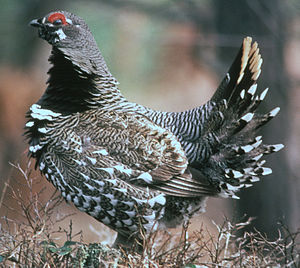Sickle fowl
| Sickle fowl | ||||||||
|---|---|---|---|---|---|---|---|---|

Grouse , male |
||||||||
| Systematics | ||||||||
|
||||||||
| Scientific name | ||||||||
| Falcipennis | ||||||||
| Elliot , 1864 |
The falcipennis ( Falcipennis ) are a species of bird from the family of pheasant-like (Phasianidae) used to order the chicken birds heard (Galliformes). As a rule, two species are now included in the genus, which occur in East Asia and North America. The closest relative is the rock mountain grouse , but they differ significantly in the appearance of the chicks, the lack of inflatable air sacs and a smaller body size.
Appearance
Both species reach a height of 38 to 43 centimeters. The fir chicken is a little lighter and weighs between 450 and 650 grams. The sickle chicken is a little heavier. Males weigh between 625 and 735 grams, females between 650 and 740 grams.
The basic color of the roosters of the sickle grouse is a dark gray-black. The head and collar are usually darker, the collar plumage is set off from the rest of the body plumage with a fine light stripe. Light, almost white spots are arranged irregularly over the entire trunk; on the belly side they show a typical heart shape. The breast shield is black. The under tail-coverts have white tips and are banded indistinctly in light gray. The tail feathers are black and have a clear white shaft line. The tips of the control springs are white. The short beak is slate gray; A white streak runs from the base of the beak to behind the eye. The dark legs are feathered down to the base of the toes. The red, bald areas of the skin over the eyes, the so-called "roses", are very strongly developed, especially in spring; they recede somewhat as the year progresses.
The males of the grouse are mostly gray-brown feathered with a black breast with white dots on the side, a black throat. The black tail has maroon tips in the nominate form. During the breeding season, the male has a red crest swelling over his eye. The male of the subspecies F. c. Living in the northern Rocky Mountains . franklinii lacks the brown tail ends; but it has white tips on the upper tail-covers.
distribution
The sickle grouse , the size of a hazel grouse, occurs mainly in the taiga of the lower Amur region and on Sakhalin . It is named after the tapering hand wings, which give the small wings a sickle-shaped shape. It is believed that stocks of the species have declined over the past 40 years; therefore the sickle grouse is currently listed in the early warning stage for endangered species. The distribution area of the coarse includes Alaska large parts of Canada as well as parts of New England , Michigan , Washington , Oregon and Idaho . The pine grouse lives in coniferous forests .
Systematics
The systematic position of the sickle fowl is unclear. This assignment to the independent genus Falcipennis is controversial: Birdlife record the two species together with the two species of rock mountain fowl ( D. obscurus and D. fuliginosus ) and the pine grouse ( D. canadensis ) in the genus Dendragapus . Morphological and behavioral similarities point to a close relationship with the fir grouse. More recent molecular biological investigations have not yet brought any final clarification of the relationships, but show a relative special position of the sickle grouse within the Falcipennis / Dendragapus group.
supporting documents
literature
- Alexander V. Andreev, Franz Hafner, Siegfried Klaus and Hartmut Gossow: Displaying behavior and mating system in the Siberian Spruce Grouse (Falcipennis falcipennis Hartlaub 1855) . In: Journal of Ornithology 142 (4) (2001): 404-424.
- David. A. Boag and Michael. A. Schroeder. Spruce Grouse (Falcipennis canadensis) . In: The Birds of North America Online (A. Poole, Ed.) Ithaca: Cornell Lab of Ornithology 1992.
- Derek E. Dimcheff, Sergei V. Drovetski, and David P. Mindella: Phylogeny of Tetraoninae and other galliform birds using mitochondrial 12S and ND2 genes. In: Molecular Phylogenetics and Evolution 24 (2002): 203-215.
- Franz Hafner, Alexander V. Andreev et al. : The sickle grouse - mysterious jungle bird in eastern Siberia Special publication by the Natural Science Association for Carinthia. Klagenfurt 1998; ISBN 3-85328-014-5
- Florian Möllers, Wiltraud Engländer, Siegfried Klaus and Alexander V. Andreev: A grouse in a dense forest - variability in the expressive behavior of the sickle grouse Falcipennis falcipennis . In: Journal of Ornithology 136 (4) (1995): 398-399.
- VD Il'ičev and VE Flint (eds.): Handbook of Birds of the Soviet Union. Vol. 4 Galliformes-Gruiformes. Ziemsen Wittenberg 1989. pp. 117–126 ISBN 3-7403-0027-2 (= VSU)
- Ilse Storch (Comp.): Grouse. Status Survey and Conservation Action Plan 2006-2010. engl. (PDF file; 4.48 MB)
- Steve Madge , Phil McGowan, and Guy M. Kirwan : Pheasants, Partridges and Grouse. A Guide to the Pheasants, Partridges, Quails, Grouse, Guineafowl, Buttonquails and Sandgrouse of the world. Christopher Helm, London 2002, ISBN 0-7136-3966-0 .
Single receipts
- ↑ Madge et al., P. 356
- ↑ Madge et al., P. 356
- ↑ Madge et al., P. 358
- ↑ Madge et al., P. 357
- ↑ Weblink data sheet Birdlife
- ↑ Boag & Schroeder (1992) Systematics
- ↑ Andreev et al. (2001) p. 420
- ↑ Dimcheff et al. (2002) p. 205